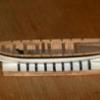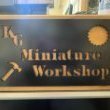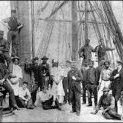-
Posts
6,365 -
Joined
-
Last visited
Reputation Activity
-
 wefalck reacted to Cowgirl in Doctor's Buggy by Cowgirl - Model Expo Trailways - 1:12 scale
wefalck reacted to Cowgirl in Doctor's Buggy by Cowgirl - Model Expo Trailways - 1:12 scale
This is my second Doctor's buggy. The first was not a very good kit and I ended up kit bashing it. This one from Model Expo was a much better kit with easier to follow instructions. It helped that I am pretty familiar with the actual antique Doctor's buggies so the kit and build made sense.
Finished:
Dr's Buggy Model Trailways 1:12 scale
Navajo Wagon - Kit bash from Model Trailways Chuckwagon 1:12 scale
In Progress:
Rucker's Ambulance Model Expo Historic Artillery
Future Project:
Model Shipways Shipwright Series?
Model Trailways Stagecoach 1:12 scale
-
 wefalck got a reaction from FriedClams in Lancha Chilota by JacquesCousteau – Scale 1:32 – Chilean Coasting Sloop
wefalck got a reaction from FriedClams in Lancha Chilota by JacquesCousteau – Scale 1:32 – Chilean Coasting Sloop
On harder woods I use single-sides razorblades as scraper (the ones that have a reinforced back). However, getting things smooth around knots may indeed be difficult. What would help is to treat the surface with a sanding-sealer. That would harden the soft fibres around the knot, making sanding/scraping easier. Another good way to smooth the surface is the use of different grades of steel-wool in between coates of sanding-sealer.
However, there is no point then applying lineseed-oil, as it would not penetrate the wood treated with sanding-sealer. There may not need to be a need for further treatment, as the wood treated with e.g. cellulose-based sanding-sealer and rubbed down with fine steelwool takes on a nice satin shine.
-
 wefalck reacted to Dr PR in CA (cyanoacrylate) "super glue"
wefalck reacted to Dr PR in CA (cyanoacrylate) "super glue"
Many on the Forum seem to prefer super glue to other cements. I dislike it!
I guess I am jinxed when it comes to super glue. I have purchased maybe six tubes in my lifetime. Of the first three one hardened in the tube before I ever got to use it. I used only a few drops from the other two before they became solid.
The only good luck I have had with it was recently. I bought a tube of Loctite gel in a fancy applicator "bottle." This was just a plastic shell with things on the sides that squeezed an ordinary tube of glue inside. I used it between one and two dozen times before the cap became glued to the tip. While trying to get the cap off the tube began turning in the plastic shell. This twisted the tube about half way along its length, trapping about half of the remaining glue in the bottom. I eventually disassembled the thing and found the top half hardened. I poked a hole in the bottom half of the tube to get a couple more drops. Then the rest hardened.
Then I bought these two tubes a couple of days ago. The instructions said to screw the end/cap pair onto the tube to puncture the thin metal diaphragm on the top of the tube. Try as I may it didn't work with the tube on the left. So I tried to puncture the diaphragm with a sharp metal point - it wouldn't puncture! The entire brand new tube was rock hard!
The second tube was still pliable so the glue inside was still liquid. I tried to open the second tube and the cap would not screw on straight and puncture the diaphragm. I punctured the diaphragm with a metal point and used the end/cap from the first tube.
So far I have gotten three small drops of glue from this second tube.
So out of six tubes of superglue I have purchased only one gave me at least half a tube of glue before it hardened. Two were hardened before I opened them. Two more solidified shortly after I opened them.
Considering the relatively high cost of this stuff, it has cost me two to three dollars per drop. That is extremely expensive!
Apparently other people have had better luck and have actually been able to use super glue regularly. Does anyone ever get to use an entire tube before it hardens? What's the secret?
****
Of course there is the other problem with super glue - the fumes are very irritating! Many glues have odors, but super glue is the worst!
****
I have several other types of glues and these last for years after opening. I have even emptied some of the containers while the glue was still good!
-
 wefalck reacted to JacquesCousteau in Lancha Chilota by JacquesCousteau – Scale 1:32 – Chilean Coasting Sloop
wefalck reacted to JacquesCousteau in Lancha Chilota by JacquesCousteau – Scale 1:32 – Chilean Coasting Sloop
Thanks, @wefalck, I'll have to look into a nitrocellulose wood sealer. The sealer/varnish I have is water based, so I don't know if it would have the same effect.
I was able to make a little progress on the turnbuckles and shroud hooks. As seen in photos like those below, these were often held together (and to the shrouds and chainplates) with rather improvised-looking lashings of wire and/or rope.
Source: https://www.bibliotecanacionaldigital.gob.cl/bnd/629/w3-article-644834.html
Source: https://www.carlosvairo.com/galeria-puerto-montt-lanchas-chilotas
While two of my turnbuckles are directly attached to the hooks, the other two are lashed in this fashion. I used 0.25mm black rope from Ropes of Scale to represent a wire lashing, and tried to get an improvised look, with the "wire" tied off in different ways. I think the lashings turned out all right (although up close the limits of my pre-made "turnbuckles" are pretty apparent--I think that making better ones would require soldering, which is a skill I don't have). I plan on using similar wire lashings to attach these turnbuckle assemblages to the chainplates, then rope lashings to attach the tops of these snugly to the shrouds.
As can be seen, there's some variation in height, which I was going for.
Finally, I temporarily tied the turnbuckles to the chainplates with flt-fishig thread, slotted the mast in place, and did another test rigging. This was useful to check how the turnbuckle assemblies looked in place, as well as to practice the rigging steps--I've learned that I need to pay attention to the order in which I run the gaff halyards through the double blocks, as it impacts which side they need to be belayed on. It also helps me get a sense of how the model will look on the stand if I go without sails. I had been considering some sort of angled stand to show it as though it was beached on its guardaplayas, but I ultimately think I like the look on a brass stand better.
-
 wefalck got a reaction from Ab Hoving in English Royal Yacht by Ab Hoving - FINISHED - CARD
wefalck got a reaction from Ab Hoving in English Royal Yacht by Ab Hoving - FINISHED - CARD
Very nice indeed 👍🏻
Did you sculpt the figures yourself? They are very well animated.
-
 wefalck got a reaction from Canute in Lula by Keith Black - FINISHED - 1:120 Scale - 1870s Sternwheeler Supply Boat for Floating Pile Driver
wefalck got a reaction from Canute in Lula by Keith Black - FINISHED - 1:120 Scale - 1870s Sternwheeler Supply Boat for Floating Pile Driver
Well, the 'hog-chains' are there to prevent exactly that, the 'hogging' of the boat. It has the same function as the girders/trusses on a bridge above the way. Shallow hulls without (external) keel may not have sufficient strength against bending/hogging, so they need these trusses in the same way a girder-bridge needs them.
These trusses are not necessarily chains, but could be iron rods or connected wooden beams. A girder structure of wooden beams could be hidden in the constructional arrangements of superstructure without being so obvious as in the old-time river-boats.
Extending the trusses/hog-chains beyond the pivotal pole of the derrick, however, could limit its range of movement. So I would doubt that in a real case they would have been extended further, though from a mechanical point this would be advantageous.
-
 wefalck got a reaction from Canute in Lula by Keith Black - FINISHED - 1:120 Scale - 1870s Sternwheeler Supply Boat for Floating Pile Driver
wefalck got a reaction from Canute in Lula by Keith Black - FINISHED - 1:120 Scale - 1870s Sternwheeler Supply Boat for Floating Pile Driver
Sorry for having tread this loose ... you could run a pair of chains (or solid bar stays) from the forward end of the canopy over the boiler further forward, say towards a point at the hull left and right of the mast.
-
 wefalck got a reaction from Canute in Lula by Keith Black - FINISHED - 1:120 Scale - 1870s Sternwheeler Supply Boat for Floating Pile Driver
wefalck got a reaction from Canute in Lula by Keith Black - FINISHED - 1:120 Scale - 1870s Sternwheeler Supply Boat for Floating Pile Driver
This is indeed how the trusses are led on riverboats and other shallow boats that do not have a strong keel as backbone.
Incidentally, such trusses already occur on ancient Egyptian boats ...
-
 wefalck got a reaction from Canute in Lula by Keith Black - FINISHED - 1:120 Scale - 1870s Sternwheeler Supply Boat for Floating Pile Driver
wefalck got a reaction from Canute in Lula by Keith Black - FINISHED - 1:120 Scale - 1870s Sternwheeler Supply Boat for Floating Pile Driver
Yep, installing chains properly tensioned is not so trivial, as they do not stretch. On the other hand, in full-scale they have the same problem and one would normally have a turnbuckle there.
Looking at the design, I was wondering, whether there shouldn't be another set of chains on the other side of the deckhouse - its structure alone would not be able to balance the strain from the sponsons, I think.
-
 wefalck got a reaction from FriedClams in Missouri, Kansas, & Texas Railroad along the Missouri River by Cathead - 1/87 (HO) scale - model railroad with steamboat
wefalck got a reaction from FriedClams in Missouri, Kansas, & Texas Railroad along the Missouri River by Cathead - 1/87 (HO) scale - model railroad with steamboat
We lived for a couple of years near a branch-line during the last days of steam back in later 1960s Germany and used to play around the embankments. One day we had to alarm the adults as indeed some shrubs/weeds had caught fire after a steam-train passed.
It seems that this, however, was less likely with coal-fired engines, while wood- (or peat-fired, as was the case for a period in Bavaria) always had those bulbous spark-arrester chimneys.
-
 wefalck got a reaction from Old Collingwood in Missouri, Kansas, & Texas Railroad along the Missouri River by Cathead - 1/87 (HO) scale - model railroad with steamboat
wefalck got a reaction from Old Collingwood in Missouri, Kansas, & Texas Railroad along the Missouri River by Cathead - 1/87 (HO) scale - model railroad with steamboat
We lived for a couple of years near a branch-line during the last days of steam back in later 1960s Germany and used to play around the embankments. One day we had to alarm the adults as indeed some shrubs/weeds had caught fire after a steam-train passed.
It seems that this, however, was less likely with coal-fired engines, while wood- (or peat-fired, as was the case for a period in Bavaria) always had those bulbous spark-arrester chimneys.
-
 wefalck got a reaction from Paul Le Wol in Lancha Chilota by JacquesCousteau – Scale 1:32 – Chilean Coasting Sloop
wefalck got a reaction from Paul Le Wol in Lancha Chilota by JacquesCousteau – Scale 1:32 – Chilean Coasting Sloop
On harder woods I use single-sides razorblades as scraper (the ones that have a reinforced back). However, getting things smooth around knots may indeed be difficult. What would help is to treat the surface with a sanding-sealer. That would harden the soft fibres around the knot, making sanding/scraping easier. Another good way to smooth the surface is the use of different grades of steel-wool in between coates of sanding-sealer.
However, there is no point then applying lineseed-oil, as it would not penetrate the wood treated with sanding-sealer. There may not need to be a need for further treatment, as the wood treated with e.g. cellulose-based sanding-sealer and rubbed down with fine steelwool takes on a nice satin shine.
-
 wefalck got a reaction from kgstakes in Missouri, Kansas, & Texas Railroad along the Missouri River by Cathead - 1/87 (HO) scale - model railroad with steamboat
wefalck got a reaction from kgstakes in Missouri, Kansas, & Texas Railroad along the Missouri River by Cathead - 1/87 (HO) scale - model railroad with steamboat
We lived for a couple of years near a branch-line during the last days of steam back in later 1960s Germany and used to play around the embankments. One day we had to alarm the adults as indeed some shrubs/weeds had caught fire after a steam-train passed.
It seems that this, however, was less likely with coal-fired engines, while wood- (or peat-fired, as was the case for a period in Bavaria) always had those bulbous spark-arrester chimneys.
-
 wefalck got a reaction from Cathead in Missouri, Kansas, & Texas Railroad along the Missouri River by Cathead - 1/87 (HO) scale - model railroad with steamboat
wefalck got a reaction from Cathead in Missouri, Kansas, & Texas Railroad along the Missouri River by Cathead - 1/87 (HO) scale - model railroad with steamboat
We lived for a couple of years near a branch-line during the last days of steam back in later 1960s Germany and used to play around the embankments. One day we had to alarm the adults as indeed some shrubs/weeds had caught fire after a steam-train passed.
It seems that this, however, was less likely with coal-fired engines, while wood- (or peat-fired, as was the case for a period in Bavaria) always had those bulbous spark-arrester chimneys.
-
 wefalck got a reaction from Ian_Grant in Missouri, Kansas, & Texas Railroad along the Missouri River by Cathead - 1/87 (HO) scale - model railroad with steamboat
wefalck got a reaction from Ian_Grant in Missouri, Kansas, & Texas Railroad along the Missouri River by Cathead - 1/87 (HO) scale - model railroad with steamboat
We lived for a couple of years near a branch-line during the last days of steam back in later 1960s Germany and used to play around the embankments. One day we had to alarm the adults as indeed some shrubs/weeds had caught fire after a steam-train passed.
It seems that this, however, was less likely with coal-fired engines, while wood- (or peat-fired, as was the case for a period in Bavaria) always had those bulbous spark-arrester chimneys.
-
 wefalck got a reaction from Jack12477 in Missouri, Kansas, & Texas Railroad along the Missouri River by Cathead - 1/87 (HO) scale - model railroad with steamboat
wefalck got a reaction from Jack12477 in Missouri, Kansas, & Texas Railroad along the Missouri River by Cathead - 1/87 (HO) scale - model railroad with steamboat
We lived for a couple of years near a branch-line during the last days of steam back in later 1960s Germany and used to play around the embankments. One day we had to alarm the adults as indeed some shrubs/weeds had caught fire after a steam-train passed.
It seems that this, however, was less likely with coal-fired engines, while wood- (or peat-fired, as was the case for a period in Bavaria) always had those bulbous spark-arrester chimneys.
-
 wefalck got a reaction from JacquesCousteau in Lancha Chilota by JacquesCousteau – Scale 1:32 – Chilean Coasting Sloop
wefalck got a reaction from JacquesCousteau in Lancha Chilota by JacquesCousteau – Scale 1:32 – Chilean Coasting Sloop
On harder woods I use single-sides razorblades as scraper (the ones that have a reinforced back). However, getting things smooth around knots may indeed be difficult. What would help is to treat the surface with a sanding-sealer. That would harden the soft fibres around the knot, making sanding/scraping easier. Another good way to smooth the surface is the use of different grades of steel-wool in between coates of sanding-sealer.
However, there is no point then applying lineseed-oil, as it would not penetrate the wood treated with sanding-sealer. There may not need to be a need for further treatment, as the wood treated with e.g. cellulose-based sanding-sealer and rubbed down with fine steelwool takes on a nice satin shine.
-
 wefalck got a reaction from Canute in Missouri, Kansas, & Texas Railroad along the Missouri River by Cathead - 1/87 (HO) scale - model railroad with steamboat
wefalck got a reaction from Canute in Missouri, Kansas, & Texas Railroad along the Missouri River by Cathead - 1/87 (HO) scale - model railroad with steamboat
We lived for a couple of years near a branch-line during the last days of steam back in later 1960s Germany and used to play around the embankments. One day we had to alarm the adults as indeed some shrubs/weeds had caught fire after a steam-train passed.
It seems that this, however, was less likely with coal-fired engines, while wood- (or peat-fired, as was the case for a period in Bavaria) always had those bulbous spark-arrester chimneys.
-
 wefalck got a reaction from Glen McGuire in Lancha Chilota by JacquesCousteau – Scale 1:32 – Chilean Coasting Sloop
wefalck got a reaction from Glen McGuire in Lancha Chilota by JacquesCousteau – Scale 1:32 – Chilean Coasting Sloop
On harder woods I use single-sides razorblades as scraper (the ones that have a reinforced back). However, getting things smooth around knots may indeed be difficult. What would help is to treat the surface with a sanding-sealer. That would harden the soft fibres around the knot, making sanding/scraping easier. Another good way to smooth the surface is the use of different grades of steel-wool in between coates of sanding-sealer.
However, there is no point then applying lineseed-oil, as it would not penetrate the wood treated with sanding-sealer. There may not need to be a need for further treatment, as the wood treated with e.g. cellulose-based sanding-sealer and rubbed down with fine steelwool takes on a nice satin shine.
-
 wefalck reacted to Valeriy V in Libertad 1925 by Valeriy V - Scale 1:100 - Spanish Type F Light Cruiser
wefalck reacted to Valeriy V in Libertad 1925 by Valeriy V - Scale 1:100 - Spanish Type F Light Cruiser
The cruiser's hull after applying the preliminary primer.
-
 wefalck reacted to Valeriy V in Libertad 1925 by Valeriy V - Scale 1:100 - Spanish Type F Light Cruiser
wefalck reacted to Valeriy V in Libertad 1925 by Valeriy V - Scale 1:100 - Spanish Type F Light Cruiser
The hull of a cruiser with openings for portholes.
-
 wefalck reacted to Valeriy V in Libertad 1925 by Valeriy V - Scale 1:100 - Spanish Type F Light Cruiser
wefalck reacted to Valeriy V in Libertad 1925 by Valeriy V - Scale 1:100 - Spanish Type F Light Cruiser
Hello everyone!
I continue working on the cruiser's hull. Installing plates covering the joints of the armor plates.
-
 wefalck reacted to Keith Black in Lula by Keith Black - FINISHED - 1:120 Scale - 1870s Sternwheeler Supply Boat for Floating Pile Driver
wefalck reacted to Keith Black in Lula by Keith Black - FINISHED - 1:120 Scale - 1870s Sternwheeler Supply Boat for Floating Pile Driver
Thank you to everyone for the kind comments and for the likes.
I got the dinghy weathered and glued down, I still need to add a coil of rope around that sprue. You can barley see that sprue in normal viewing. I used a brown pastel to weather the inside of the dinghy but it's got a pinkish tint to it. I know not why and I'm not sure how to fix it other use a little black?
I received a box of three cats today from an Etsy supplier. They're supposed to be HO scale but they seem smaller which is okay. The one sitting on the fire bucket box is 0.115 inches high. To see any detail it must be viewed under magnification.
It snuck aboard and I'm really not in favor of it sticking around as I think it's bad luck to have a black cat onboard. I've temporally named the cat, D1.
This cat sharpening it's claws on topping lift line I named Stump Grinder. It's more or less the lead deckhand's cat. It's a little bigger than D1.
I couldn't get a good in focus photo of the cat laying on its belly beside the Derrick crane mast. This cat doesn't have a name yet. It's larger in girth than Stump Grinder. I may name it D8.
If you think I'm procrastinating doing the handrails you are correct.
Thank you to everyone for the support and for following along.
Keith
-
 wefalck reacted to JacquesCousteau in Lancha Chilota by JacquesCousteau – Scale 1:32 – Chilean Coasting Sloop
wefalck reacted to JacquesCousteau in Lancha Chilota by JacquesCousteau – Scale 1:32 – Chilean Coasting Sloop
I've made a bit of progress on the rigging, painting the shroud hooks and adding the traveler block, below. For the latter, I left the hook as unpainted annealed wire, as I needed to bend it shut around the horse. The color difference doesn't stand out too much, thankfully.
I also made more progress on the cherry base. After a bit more searching, I think the gouging I mentioned above may have been tear-out from where the grain direction shifted around the knot. After a lot of sanding didn't quite get rid if it, I tried to use a cabinet scraper. Despite following a lot of "how to" videos, I couldn't get a good burr on it, and it only ever produced dust instead of shavings. So, I kept sanding. Finally it seemed acceptable. At that point, I cut out the base, adding a point at each end, which I accidentally made sharper than I had planned--good reminder to measure twice, cut once! I also lightly beveled the edges with my mini plane.
I then cut out the 3/32-inch brass tube supports, using my razor saw. As I didn't quite get the holes drilled perfectly in the keel, I had to add some slight bends to get the supports right. Next, I drilled the holes for the supports in the base--this time triple-checking they were properly lined up and measured before drilling. Finally, I was able to dry fit the hull. I'm pleased with how the base has turned out, although I still need to decide how to finish it--I do have some linseed oil that I'm testing on some scrap, although it will take a long time to dry. I also need to slightly adjust the bends in the brass tubes, and to think about how I want to orient the model on the base.
Next up, I need to figure out the deck cargo and furnishings/fittings, and finish the rigging. On the latter, if I complete the build without sails, there's relatively little left to do--just add the mainsheet and its boom block, add the lifts and sheets, and add thimbles to the shrouds and forestay and tie them off. But, if I want sails, it will be much easier to fit them with the mast off the hull and add the mast at the very end.
-
 wefalck reacted to Cathead in Missouri, Kansas, & Texas Railroad along the Missouri River by Cathead - 1/87 (HO) scale - model railroad with steamboat
wefalck reacted to Cathead in Missouri, Kansas, & Texas Railroad along the Missouri River by Cathead - 1/87 (HO) scale - model railroad with steamboat
Thanks for sharing those great photos! You've done a nice job on your scenery. Do keep in mind that I'm modeling late fall / early winter, so a lot of the standard foliage products won't work for me. I also prefer to minimize the use of artificial stuff, though I'll certainly be using some. One of the reasons I'm focusing on this season is that it lets me use a much higher percentage of natural materials. But, for example, I intend to use some purchased static grass to help simulate the winter grasses so distinctive in this part of the world.
There will be plenty of fallen limbs/timber, especially along and in the creek. But on the other hand, keep in mind that this was the era when trees were at a minimum, so to speak, given the local demands for timber and firewood. Check out the historical photos posted earlier in the thread; the landscape was a lot more open than the lush regrowth people take for granted today. One of my interesting challenges will be balancing a historically accurate level of vegetation with an easily believed/accepted look, because modeling this truly accurately would make many modern viewers think it was farther west in, say, Montana, because they associate modern Missouri with lush (almost overwhelming) vegetation rather than the sparser "frontier" look it had around 1900.











